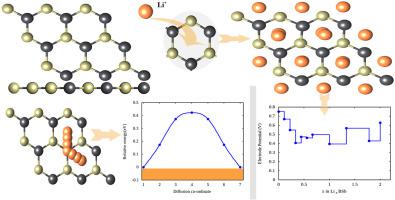Materials Chemistry and Physics ( IF 4.3 ) Pub Date : 2021-09-09 , DOI: 10.1016/j.matchemphys.2021.125191 A. Elomrani 1 , M. Lamhani 1 , S. Oukahou 1 , K. Sbiaai 1 , S. Lebègue 2 , A. Hasnaoui 1

|
Lithium-ion batteries (LIBs) are the most used systems for storing energy, however finding appropriate negative electrodes is a key factor for developing new LIBs with better performances. Based on first principle calculations, we suggest a two dimensional material, honeycomb boron antimony (h-BSb), as a high quality anode material for LIBs. The strong interaction between Li-ions and the h-BSb mono-layer suggests that lithium atoms do not prefer clustering during the lithiation process. Our results showed that the h-BSb mono-layer has undergone a semiconductor-to-metal transition upon lithiation starting from the first adsorbed Li-ion. The relatively high ionic conductivity and low barrier energy 0.42 eV of Li-ion on the h-BSb mono-layer suggest the suitability of this compound for an efficient charge/discharge process. Also, we obtained a specific capacity up to 404.4 mAhg−1 for Li-ions, which is higher than that of the graphite anode. All these characteristics suggest that the h-BSb mono-layer is a promising anode material for the next generation of LIBs.
中文翻译:

从头算模拟研究的二维 h-BSb 单层作为一种有前途的锂离子电池负极材料
锂离子电池 (LIB) 是最常用的储能系统,但找到合适的负极是开发具有更好性能的新型 LIB 的关键因素。基于第一性原理计算,我们建议使用二维材料蜂窝硼锑(h-BSb)作为 LIB 的高质量负极材料。锂离子和 h-BSb 单层之间的强相互作用表明锂原子在锂化过程中不喜欢聚集。我们的结果表明,从第一个吸附的锂离子开始,h-BSb 单层在锂化时经历了半导体到金属的转变。h-BSb 单层上锂离子的相对较高的离子电导率和 0.42 eV 的低势垒能表明该化合物适用于有效的充电/放电过程。还,-1为锂离子,高于石墨负极。所有这些特性表明 h-BSb 单层是下一代 LIB 的有前途的负极材料。











































 京公网安备 11010802027423号
京公网安备 11010802027423号